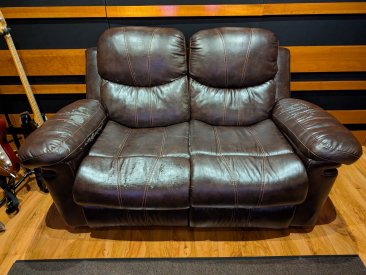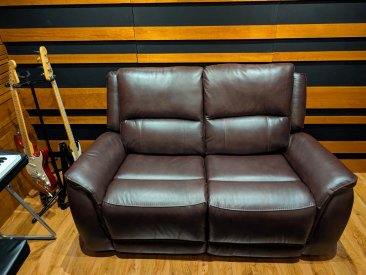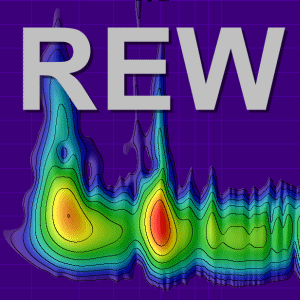Michael Toor
Registered
Thread Starter
- Joined
- Oct 13, 2017
- Posts
- 8
Hi everyone,
I have a home studio and worked with an acoustic designer to build it. He designed it and I did the construction. Throughout the process, I used REW to coordinate the status of the control room to him (he lives halfway around the world). I'm very grateful for this software and how much it has helped me. In the final stages, my designer had me try various filter settings on the FBQ2496 unit in my chain to get the mix position sounding as flat as possible.
The reason for this post is that I seem to no longer be able to reach the designer who created the filter set (attached) and I want to verify my filter settings. I've changed out the carpet in the control room for one slightly thicker one (the old one's edges were curling all around) and wanted to make sure the mix position is still sounding as good as possible. However, I'm not sure how calculating filter settings works. I took some REW tests before and after changing the carpet out and my plan was to just look at the SPL curves, RT60 graphs, and Waterfall Graphs to determine if much changed. From what I can see, those seem to look consistent at a glance, however I'm not experienced in acoustical analysis. The extent of my use of REW has just been calibrating the system and generating test results for the designer I worked with.
I would greatly appreciate it if someone with experience could help me out here by taking a look at my results and the filter settings (which were applied during all of the tests since the FBQ2496 unit was active in the chain) and verify if I need to change anything. I noticed when I sat down after switching out the carpet to test some music, it felt like the music sounded much tinnier and the mids/body of the sound was lacking. I could just be paranoid but it would help to have someone who understands REW tests better to verify. I've attached the REW tests.
A few things that might be worth noting:
- I set the soundcard and mic calibration files prior to running any tests
- I'm not sure if I was supposed to add the filter set somewhere before running the tests but I added the filter set to each of the tests AFTER running all of them just so you can see the values used. I'm not sure if that warps any results but if so, just remove the filter settings and you'll see the results as they were when the tests were run --- with the FBQ2496 unit active in the chain but the settings not applied in REW itself
- There are 8 tests in total; the first four with the old carpet and the other 4 with the new carpet
- Test one is with the mixing desk chair placed right behind the mic stand and me crouched in the room under the mixing desk
- Test two is with the mixing desk chair placed right behind the mic stand and me outside of the room entirely
- Test three is with the mixing desk chair placed in the back corner of the room and me crouched in the room under the mixing desk
- Test four is with the mixing desk chair placed in the back corner of the room and me outside of the room entirely
- The next four tests were the same scenarios in the same order but with the new carpet instead of the old one
- The monitors being used are Adam A7X satellites with an Adam Sub8 (the designer chose the settings for the EQs, etc. as well for these)
- I can't quite remember for sure and can't check because the speakers are in an elaborate enclosure but I think the tweeters were set to +4 and the lows were -5 for the satellites
- The sub crossover is around 130 Hz I believe and I think the phase was 0 with the 85 Hz cutoff applied before sending the L and R signals out to the satellites
I would also appreciate your thoughts in general on how the filter set was working prior to changing the carpet. Was the calibration done correctly with my studio designer? It sounded pretty flat but please let me know.
Thank you for taking the time to read all that and again I would greatly appreciate any help and advice.
- Michael
UPDATE: I had to divide the .mdat into two due to file size, so Part 1 contains tests 1-4 and Part 2 contains tests 5-8
I have a home studio and worked with an acoustic designer to build it. He designed it and I did the construction. Throughout the process, I used REW to coordinate the status of the control room to him (he lives halfway around the world). I'm very grateful for this software and how much it has helped me. In the final stages, my designer had me try various filter settings on the FBQ2496 unit in my chain to get the mix position sounding as flat as possible.
The reason for this post is that I seem to no longer be able to reach the designer who created the filter set (attached) and I want to verify my filter settings. I've changed out the carpet in the control room for one slightly thicker one (the old one's edges were curling all around) and wanted to make sure the mix position is still sounding as good as possible. However, I'm not sure how calculating filter settings works. I took some REW tests before and after changing the carpet out and my plan was to just look at the SPL curves, RT60 graphs, and Waterfall Graphs to determine if much changed. From what I can see, those seem to look consistent at a glance, however I'm not experienced in acoustical analysis. The extent of my use of REW has just been calibrating the system and generating test results for the designer I worked with.
I would greatly appreciate it if someone with experience could help me out here by taking a look at my results and the filter settings (which were applied during all of the tests since the FBQ2496 unit was active in the chain) and verify if I need to change anything. I noticed when I sat down after switching out the carpet to test some music, it felt like the music sounded much tinnier and the mids/body of the sound was lacking. I could just be paranoid but it would help to have someone who understands REW tests better to verify. I've attached the REW tests.
A few things that might be worth noting:
- I set the soundcard and mic calibration files prior to running any tests
- I'm not sure if I was supposed to add the filter set somewhere before running the tests but I added the filter set to each of the tests AFTER running all of them just so you can see the values used. I'm not sure if that warps any results but if so, just remove the filter settings and you'll see the results as they were when the tests were run --- with the FBQ2496 unit active in the chain but the settings not applied in REW itself
- There are 8 tests in total; the first four with the old carpet and the other 4 with the new carpet
- Test one is with the mixing desk chair placed right behind the mic stand and me crouched in the room under the mixing desk
- Test two is with the mixing desk chair placed right behind the mic stand and me outside of the room entirely
- Test three is with the mixing desk chair placed in the back corner of the room and me crouched in the room under the mixing desk
- Test four is with the mixing desk chair placed in the back corner of the room and me outside of the room entirely
- The next four tests were the same scenarios in the same order but with the new carpet instead of the old one
- The monitors being used are Adam A7X satellites with an Adam Sub8 (the designer chose the settings for the EQs, etc. as well for these)
- I can't quite remember for sure and can't check because the speakers are in an elaborate enclosure but I think the tweeters were set to +4 and the lows were -5 for the satellites
- The sub crossover is around 130 Hz I believe and I think the phase was 0 with the 85 Hz cutoff applied before sending the L and R signals out to the satellites
I would also appreciate your thoughts in general on how the filter set was working prior to changing the carpet. Was the calibration done correctly with my studio designer? It sounded pretty flat but please let me know.
Thank you for taking the time to read all that and again I would greatly appreciate any help and advice.
- Michael
UPDATE: I had to divide the .mdat into two due to file size, so Part 1 contains tests 1-4 and Part 2 contains tests 5-8
Attachments
Last edited:















